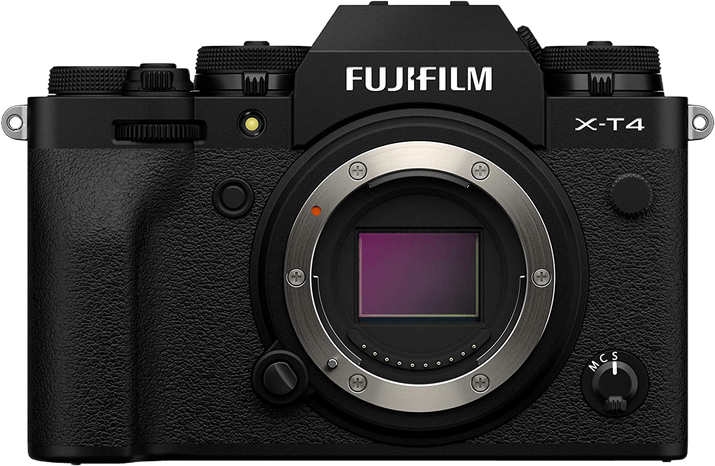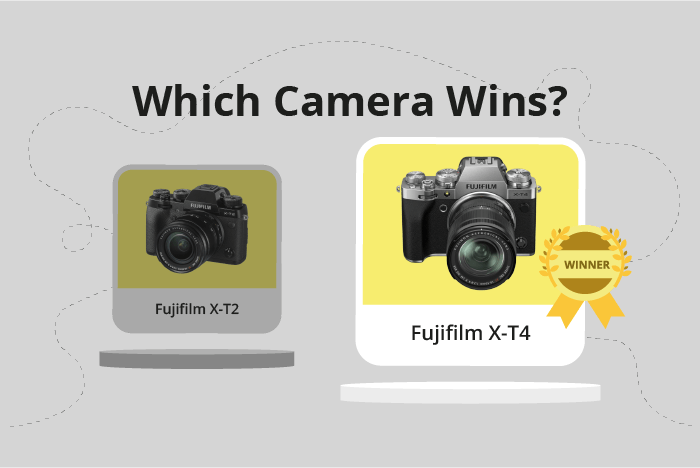Fujifilm X-T2 vs X-T4 Comparison
Fujifilm X-T2

Fujifilm X-T4

The Fujifilm X-T4 outshines the X-T2 with a score of 76/100 compared to 68/100. Both cameras are mirrorless and share similar dimensions, with the X-T4 being slightly larger and heavier. The X-T4, released in 2020, offers improved performance and features compared to the X-T2, which came out in 2016.
The X-T4’s higher score is due to its more advanced capabilities, making it a better camera for photographers seeking the latest technology. However, the X-T2 still holds its ground as a reliable option, especially considering its lower launch price of $1599 compared to the X-T4’s $1699.
Taking these factors into account, the Fujifilm X-T4 is the superior choice for those prioritizing advanced features, while the X-T2 remains a solid option for those seeking a more budget-friendly camera.
Fujifilm X-T2 vs X-T4 Overview and Optics
The Fujifilm X-T4 wins the optics comparison with a score of 73/100, while the Fujifilm X-T2 scores 66/100. Both cameras share several specifications, including a CMOS sensor type, APS-C sensor size, Fujifilm X lens mount, and the absence of a DXOMARK score. Despite these similarities, the X-T4 surpasses the X-T2 in several ways, leading to its higher score.
The X-T4 has a 26-megapixel sensor, compared to the X-T2’s 24-megapixel sensor. This higher resolution allows the X-T4 to capture more detail and produce sharper images. Additionally, the X-T4 has a faster shooting speed of 20 frames per second, compared to the X-T2’s 14 frames per second. This faster speed enables the X-T4 to better capture fast-moving subjects and events.
One significant advantage of the X-T4 over the X-T2 is its image stabilization feature. The X-T4’s built-in image stabilization helps reduce camera shake and blur, resulting in clearer, sharper images, especially in low-light situations or when using longer focal lengths. The X-T2 lacks this feature, making it more susceptible to blurry images due to camera shake.
The X-T2, however, does have its merits despite its lower score. Its X-Processor Pro is still a capable processor, delivering fast performance and good image quality. While it may not be as advanced as the X-T4’s X-Processor 4, the X-T2 remains a respectable option for photographers who prioritize speed and performance.
To conclude, the Fujifilm X-T4 outperforms the X-T2 in terms of optics, with higher resolution, faster shooting speed, and image stabilization. The X-T2 remains a solid choice for those who prioritize performance, but the X-T4’s improved features make it the superior choice for photographers seeking the best image quality and versatility.
Fujifilm X-T2 vs X-T4 Video Performance
The Fujifilm X-T4 outperforms the X-T2 in video capabilities with a score of 91/100 compared to the X-T2’s 83/100. Both cameras share some common specifications, including 4K max video resolution and built-in time-lapse functionality. However, there are key differences that set the X-T4 apart as the superior choice for video recording.
The X-T4 has a higher max video dimension of 4096 x 2160, while the X-T2 reaches 3840 x 2160. This difference means that the X-T4 captures more detail and produces higher quality video output. Moreover, the X-T4 offers a remarkable max video frame rate of 120fps, doubling the X-T2’s 60fps. This higher frame rate allows for smoother slow-motion footage and enhanced video performance, particularly in action or sports settings.
On the other hand, the X-T2 does not have any notable advantages in its video capabilities over the X-T4. The X-T4 simply surpasses the X-T2 in essential video specifications, making it the clear winner in this comparison.
In light of these findings, the Fujifilm X-T4 is the better option for videographers and enthusiasts seeking high-quality video performance. Its superior max video dimensions and frame rate provide users with more flexibility and creative possibilities, while the shared 4K resolution and time-lapse functionality ensure that both cameras meet the modern videography standards. As a result, the X-T4 is the recommended choice for those prioritizing video capabilities in their camera selection.
Fujifilm X-T2 vs X-T4 Features and Benefits
The Fujifilm X-T4 outperforms the Fujifilm X-T2 with a feature score of 85/100, compared to the X-T2’s 70/100. Both cameras share some specifications, including a 3-inch screen size, flip screen, lack of GPS, and the presence of WIFI and Bluetooth connectivity.
The X-T4 surpasses the X-T2 in screen resolution and touchscreen functionality. The X-T4 has a screen resolution of 1,620,000 dots, making it sharper and providing better image quality than the X-T2’s 1,040,000 dots. Additionally, the X-T4 has a touchscreen, which the X-T2 does not. This feature allows users to navigate menus and settings more efficiently, as well as quickly focus on subjects and review images.
The X-T2, although lower in score, still has its advantages. The flip screen, WIFI, and Bluetooth features it shares with the X-T4 ensure that it remains a competent choice for photographers seeking these functionalities. However, the X-T4’s higher screen resolution and touchscreen make it the better option for those who prioritize image quality and user experience.
Comparing the Fujifilm X-T2 and X-T4, it is clear that the X-T4 stands out as the superior camera due to its enhanced features, such as the higher screen resolution and touchscreen capability. While the X-T2 remains a viable option, the X-T4’s improved specifications make it the more appealing choice for photographers seeking top-notch image quality and ease of use.
Fujifilm X-T2 vs X-T4 Storage and Battery
The Fujifilm X-T4 outperforms the X-T2 in storage and battery, scoring 73/100 compared to the X-T2’s 68/100. Both cameras share common specifications, such as two memory card slots and compatibility with SD, SDHC, and SDXC (UHS-II) memory cards. They also both feature USB charging capabilities.
The X-T4’s superiority lies in its battery life and battery type. With a battery life of 500 shots, it surpasses the X-T2’s 340 shots, providing users with more shooting time before needing to recharge. Additionally, the X-T4 uses the more powerful NP-W235 battery, while the X-T2 relies on the NP-W126S.
Despite its lower score, the X-T2 still offers reliable storage and battery performance suitable for various photography needs. However, the X-T4’s extended battery life and enhanced battery type make it the better choice for those requiring longer shooting sessions and a more robust battery.
In comparing these two cameras, the Fujifilm X-T4 clearly stands out in terms of storage and battery performance, offering users increased reliability and convenience for their photography endeavors.
Fujifilm X-T2 vs X-T4 – Our Verdict
Are you still undecided about which camera is right for you? Have a look at these popular comparisons that feature the Fujifilm X-T2 or the Fujifilm X-T4:

